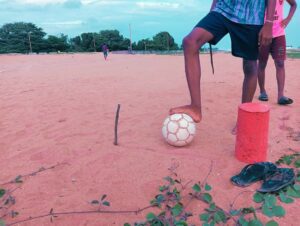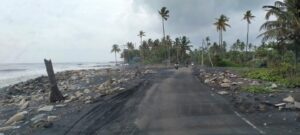The ₹6,500-crore Thiruvananthapuram-Kasargod highway along the Arabian Sea faces resistance due to livelihood, environment concerns.

Sea erosion has already destroyed many houses at Anchuthengu in Thiruvananthapuram. The proposed highway is to pass through this region. (KA Shaji)
Yet another ambitious project of the Pinarayi Vijayan-led LDF government — a ₹6,500 crore coastal highway — has hit the chicane with the Opposition UDF contending it is unfeasible and will do little to contribute to Kerala’s growth.
As the government goes ahead with the project, ignoring displacement and livelihood concerns, the affected coastal populace is also up in arms and organising themselves to oppose the highway that is expected to run along the coast for the entire length of the state .
A UDF sub-committee led by Revolutionary Socialist Party (RSP) leader Shibu Baby John spent about three months studying the project in detail and interacting with fish workers and coastal experts in nine districts through which the highway has been planned.
Speaking to South First, John said the project, which would run parallel to the Arabian Sea between Kasaragod and Thiruvananthapuram, would be an environmental disaster, besides affecting the livelihood of the entire sea-dependent community in the state.

A sea erosion prone area of Pozhiyoor village where the proposed coastal highway begins. (KA Shaji/South First)
Citing the large displacement of coastal villages inhibited by poor fishing community families, the sub-committee recommended the UDF leadership strongly oppose the coastal highway. It also suggested launching agitations against the project.
“We studied the project in depth with the help of experts. Going by the proposed alignment, the project would contribute nothing to the overall development of Kerala. Instead, it will cause massive displacement of the fishing community,” John said.
Strikingly, the proposed highway runs almost parallel to the existing national highway, and in some parts, the distance between the two is hardly 50 metres.
“The maximum distance between the two is 15 km, and that too, in a few stretches,” the RSP leader said, describing the scheme as a real estate project with the sole intention of making money by sacrificing the interests of the fishing community.
The six-lane highway, it is estimated, will have a length of 625 km when completed.
According to Opposition leader VD Satheesan, the sub-committee was deputed to evolve a realistic approach to the coastal highway project, keeping away from partisan politics and pushing forward the larger interests of the affected fishing community.

The pink stone, marking the alignment of the proposed coastal highway in a Thiruvananthapuram coastal village. (KA Shaji/South First)
He said the UDF would soon evolve strategies to fight the highway project based on the sub-committee’s recommendations.
For the LDF government, the UDF’s opposition to the project is a severe setback, especially against the backdrop of the simmering anger among the state’s coastal communities towards the ruling dispensation.
If the government goes ahead with the proposed project, it might suffer the same fate as the multi-crore SilverLine semi-highspeed rail project, which is now in cold storage, following people’s resistance.
Most infrastructure projects taken up by the Vijayan government have caused massive public uproar because of the environmental and livelihood losses involved.
In the case of the coastal highway, the fishing community has been accusing the government of pushing forward the project without conducting any environmental or social impact studies, or preparing a detailed project report (DPR).
Even though the project is in its rudimentary stages, the government has already faced stiff resistance from the fishing community after the authorities planted pink-coloured marker stones demarcating the boundaries of the proposed highway in many coastal villages.
Interestingly, most of the stones laid at Pozhiyoor in Thiruvananthapuram — the southernmost village where the highway would start — have been submerged in the surging sea waters during this year’s Southwest Monsoon, which has caused massive coastal erosion.

A coastal village in Kollam through which the alignment of the coastal highway would pass. (KA Shaji/South First)
For the government, the project is a highway to accelerate coastal tourism, and it involves a dozen commercial and tourism hubs, the longest cycle track in the country, electric vehicle charging stations, bus bays, and many other means to attract foreign and domestic visitors.
Though the UDF and other opposition political formations have not yet made any policy-level decision to oppose the project, the survey and boundary demarcation activities have evoked angry responses from the fishing community. They accused the project of being part of a larger conspiracy to appropriate fishing and seashore maintenance rights from them.
Fish workers’ community leader Magline Peter told South First that action committees have already been formed in Thiruvananthapuram, Kollam, Thrissur, and Kozhikode districts against the project. Protests, including uprooting the pink stones, are on the cards.
According to her, the Kerala coast is already under stress due to climate change and human factors.
“Constructions, including the Vizhinjam Harbour and Cochin Shipyard, have heavily impacted the coastal ecology, causing large-scale destruction of our livelihood. Coastal erosion is severe in most places, and it would be difficult for the coast to bear the impact of such a huge highway that would deny us many rights, including easy access to the sea, drying of fishing nets on the beaches, and having recreational facilities on the coast,” she said.
According to PWD officials, the proposed highway will pass through 20 coastal grama panchayats, 11 municipalities, and four corporations. As much as 540.61 hectares would have to be acquired to implement the project.
“The tragedy is that the government keeps the coastal community in the dark regarding the project and its details. Without any initiative to win over the confidence of the local communities, the government is laying boundary stones across the nine districts,” academic and activist J Devika said.
“Revenue officials are installing pink stones under police protection and employing coercion tactics against the agitating fish workers. This is unacceptable in a democratic society,” she told South First.
Though the fishing communities have submitted a “mass memorandum” to the chief minister, no follow-up action has been made.
“The Kerala government has a dubious track record of not rehabilitating coastal communities facing displacement for years due to infrastructural projects. Now they are pushing forward mega infrastructure projects along the same coast even while denying fisherfolk the right to construct homes,” a coastal community leader AJ Vijayan said.
Expected to be completed in another three years, the project envisages constructing 470 km of the new road apart from merging existing roads and developing them.
“At one level, the government is forcing the fishing community to relocate to safer places, citing the increasing coastal erosion. On the other hand, it is implementing a project to establish roads and tourism hubs in areas highly prone to erosion. The government is bound to explain this paradox to the public,” environmentalist Sridhar Radhakrishnan demanded.
Meanwhile, a senior official with the Kerala Road Fund Board, which is implementing the highway project, said the demarcation stones were laid as part of the efforts to ensure clarity on the project’s alignment. The stones would help in conducting the social impact and environmental assessment studies.
The official also said that the DPR was in the final stages of preparation.
He said the government has already announced compensation packages for the affected families, and they are higher than the national average.
The recently constituted Kerala State Coastal Development Corporation will act as the nodal agency in charge of rehabilitation, he added.

May 17, 2024

May 17, 2024

May 16, 2024

May 16, 2024

May 16, 2024

May 15, 2024